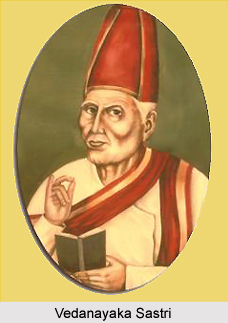 Vedanayaka Sastri was a famous Tamil Poet from Tanjore. Born in Tirunelveli in 1774 as the son of Devasahayam Pillai, a Catholic of Shaiva Vellala background, Vedanayaka Sastri initially received schooling in the traditional Tamil manner in Puliyangudi in the Tirunelveli district. In 1785, after Devasahayam Pillai converted to the Evangelical Protestantism propagated by the Halle missionaries, the eleven-year old boy was sent to Tanjore with the celebrated German Protestant missionary Christian Friedrich Schwartz. Following instruction on a personal basis with Schwartz, Sastri attended the missionary school in Tanjore. In 1789 he was sent to the theological seminary for Indian catechists at Tranquebar, where he studied theology, astronomy, anatomy and mathematics with C.S. John and other German missionaries. In 1794, at the age of nineteen, he was appointed to the head mastership of the Tamil seminary Schwartz had established in Tanjavur for training Indian catechists. There Sastri taught mathematics and astronomy, and trained catechists.
Vedanayaka Sastri was a famous Tamil Poet from Tanjore. Born in Tirunelveli in 1774 as the son of Devasahayam Pillai, a Catholic of Shaiva Vellala background, Vedanayaka Sastri initially received schooling in the traditional Tamil manner in Puliyangudi in the Tirunelveli district. In 1785, after Devasahayam Pillai converted to the Evangelical Protestantism propagated by the Halle missionaries, the eleven-year old boy was sent to Tanjore with the celebrated German Protestant missionary Christian Friedrich Schwartz. Following instruction on a personal basis with Schwartz, Sastri attended the missionary school in Tanjore. In 1789 he was sent to the theological seminary for Indian catechists at Tranquebar, where he studied theology, astronomy, anatomy and mathematics with C.S. John and other German missionaries. In 1794, at the age of nineteen, he was appointed to the head mastership of the Tamil seminary Schwartz had established in Tanjavur for training Indian catechists. There Sastri taught mathematics and astronomy, and trained catechists.
Sastri spent the major portion of his life in the city of Tanjore in the seventeenth and eighteenth centuries, under the rule of the Telugu Nayakas and the western Indian Marathas, Tanjore was an important cultural centre and the site of a great flowering of literature, drama, dance, music and other arts. The literature that was developing in Tanjore at this point in time highlighted the heterogeneous world of South India in the eighteenth century, a time of heightened social and cultural changes inspired by encounters among peoples of various ethnicities, including Europeans.
Vedanayaka Sastri`s career as a literary figure was shaped by his unique position in the development of the Tamil Protestant church in Tanjore at an important time in its history. Although he was a major agent of the Halle missionaries in the dissemination of European learning and was familiar with English, he mostly devoted his time to to writing, performing and expounding original Tamil works. While he wrote several prose tracts and pamphlets in Tamil, and even a Tamil textbook of arithmetic, his major works were in poetic, literary and musical genres. These included short poems which put together doctrinal material for the use of catechists, religious poetry for children to recite, poems for Tamil Evangelical festivals and family occasions, and more than 500 devotional hymns. The hymns were written mainly for use in personal worship, but some of them were composed in the Raagas (melodic type) and Talas (beat pattern) of classical South Indian Carnatic music. In several of his works he incorporated material and ideas from European scientific systems, especially mathematics, astronomy, geography, anatomy and natural history. Congregations of that time greatly appreciated the poet`s public performances of his works.
The range and originality of Vedanayaka Sastri`s writings were remarkable by any standard. It is for his achievement as a poet that Sastri was celebrated in his own time and continues to be remembered in Tamil literary history.



















